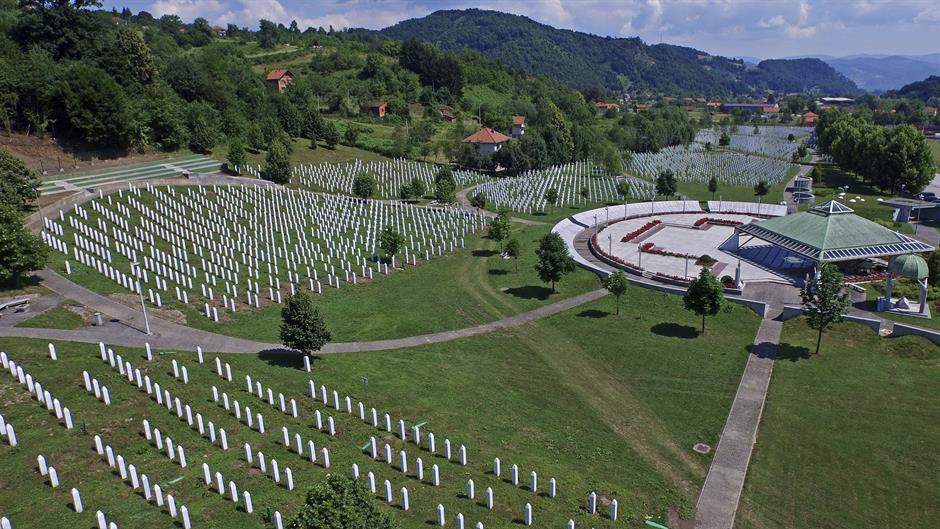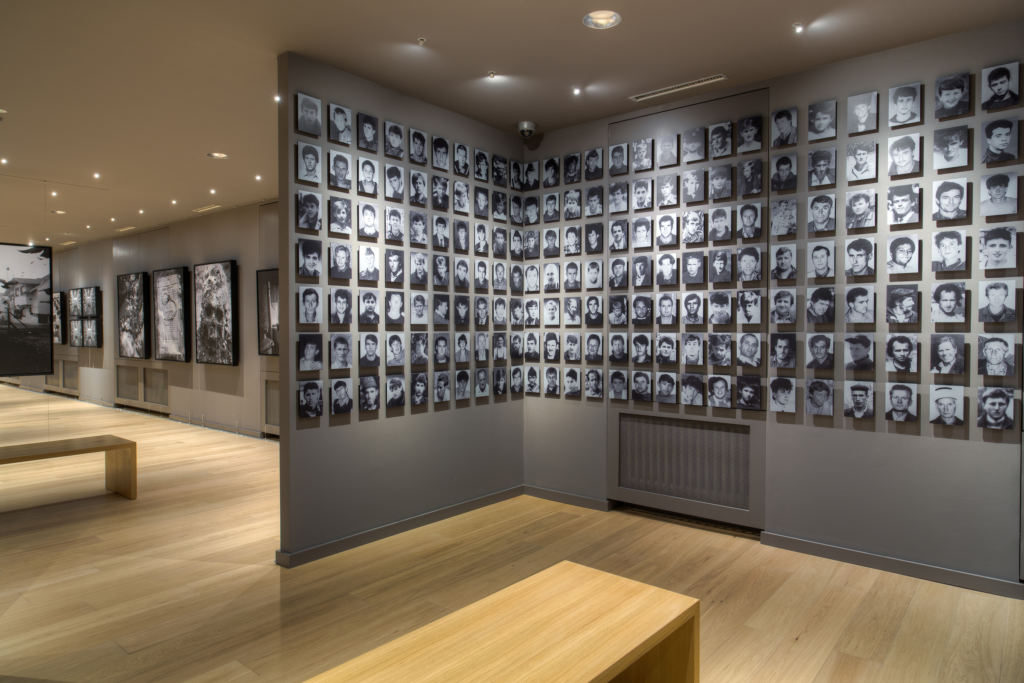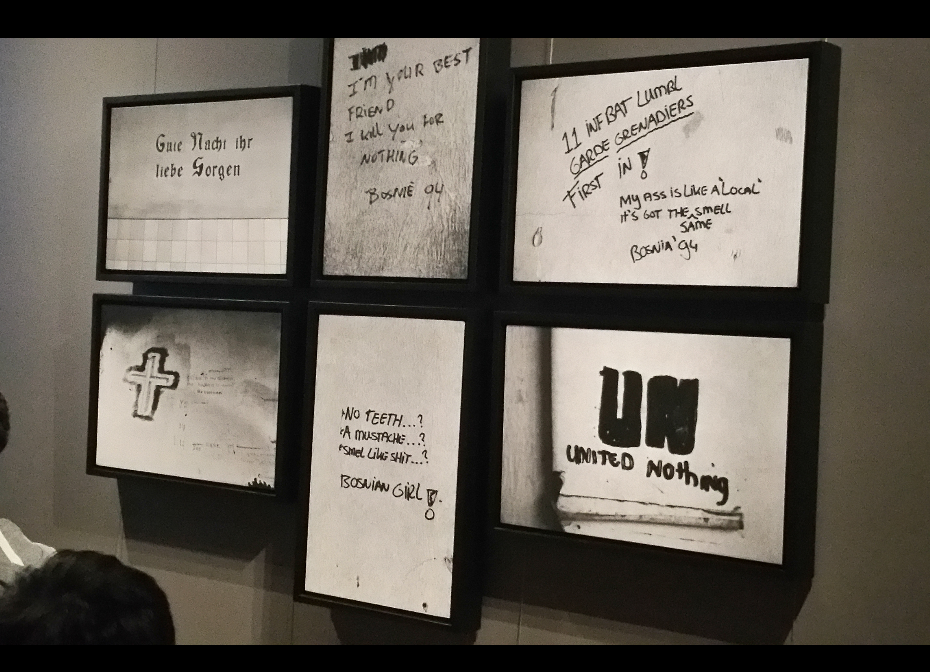Gallery 11/07/95.
Since I expect most of my readers to be American, I’ll start with a reminder regarding the museum’s name. The typical date format used in the US is Month/Day/Year. In Europe, the format is Day/Month/Year. Thus, while Europeans effortlessly read the above date as 11 July 1995, Americans need to pause and remind themselves that this date is not November 7 but is, in fact 11 July – a task the TTS cannot complete in its American incarnation. (Once in the museum proper, photography isn’t permitted so I have downloaded a few pictures from other internet sites.)
Visitors to Sarajevo as recently as four years ago would not have been able to visit this space of remembrance of the Srebrenica Massacre. The museum, a mixture of history and art, opened on 12 July 2012 hoping that by choosing to open the day after the anniversary of Srebrenica’s fall to Serbian forces, while perpetuating the memory of Srebrenica’s suffering, it would also mark a point for the world to begin to nurture a culture of memory of the genocide perpetrated there.
Why, you might wonder, would the creators of the Gallery place it in Sarajevo and not in Srebrenica itself or even at the memorial in Potočari where more than 3,000 victims are buried. (Photo below from the Skyscraper City Board)

Through their ethnic cleansing the Serbs created a set of “facts on the ground.” This is a difficult area to reach but it’s also now part of the Republika Srpska. It’s reasonable to conclude that they’d see an exhibition portraying Serbian actions as genocide as problematic.
Enter the Gallery through a rather nondescript and unassuming door then walk up a few flights of stairs (there’s a small elevator for disabled visitors) to reach the exhibit space. At the top of the stairs, you come face to face with a wall listing the names and ages of the victims. It’s called the Wall of Death and it’s 16 meters long. As you turn to enter the small shop to purchase your entry ticket, the next image you face is this one.

Entering the main exhibition space you start in a room with photos of 640 individuals – fewer than one tenth of the people slaughtered (photos from the Gallery 11/07/95 website).

Next, you pass into the permanent exhibition simply called “Srebrenica.” I read that the exhibition has as one of its goals balancing respect for the victims and their families while at the same time showing the crime that was committed and making visitors remember it. For me, it succeeded.
This blend of art and history is, I think, best represented in the photos of Tarik Samarah. In this part of the exhibition, you stand face to face with a series of stark black and white images. Just as they confront you, you must confront them. These images make you a witness. They force you to ponder whether your indifference makes you a tacit collaborator.
Children swinging on a tire. A simple pair of clasped hands – perhaps a father and daughter. A boy shooting an arrow into the air. A recognizable universal humanity permeates these photos.
A child’s doll – abandoned, its mouth contorted from where its head has been riven in two lies on the ground as ants crawl across it. A person’s skull half buried. The humanity that preceded the photo touches you but the image has twisted it into some perverse vision. A sort of anti-humanity if you will.
Samarah also included photos of graffiti scrawled by the Dutch peacekeeping troops. As the siege tightened the supply convoys reaching the city became rarer. Without food, water, medicine, cooking, or heat people began to do whatever they could to survive. Desperate people do desperate things. Lawlessness, violence, theft, and black marketeering became the norm. Girls turned to prostitution. The undermanned Dutch troops faced many of the same privations as Srebrenica’s population and had prohibitions against engaging in battle. They came to view their mission as untenable and the people they had been sent to protect as less than human. I downloaded this Samarah photo of Dutch graffiti from a website called Justice for Bosnia.

You can see this and many of the other images I’ve described in this video. Watch if you are brave enough:.
There is an interactive area called “Mapping Genocide” that consist mainly of texts, drawings, photographs, and videos organized chronologically. It allows you to trace the war’s various genocides as thoroughly as you can emotionally bear.
From there you can move to a gallery displaying a series of movie and advertising posters where the title or product has been turned into an ironic commentary on the situation. Like Sarajevo, these were contrastingly funny and heartbreaking. Sadly, I couldn’t find any photos of them.
Continuously running videos, both documentary and imaginative, are dispersed throughout the space. We saw one entitled “Srebrenica Memorial Film” by Leslie Woodhead and Muhamed Mujkić. The film has first-hand accounts and includes some previously unseen footage from Srebrenica in the hours leading up to the massacre.
I think it was here that we also saw a short film called “Miss Sarajevo” – a documentary by Bill Carter, an American journalist. It’s about a 1993 beauty contest – the “Miss Besieged Sarajevo Beauty Pageant” – held in the basement of a building (to stay safe from sniper fire). At one point, the women in their swimsuits hold a banner that says, “DON’T LET THEM KILL US.” Bono wrote and U2 recorded the song Miss Sarajevo that was released on the 1995 collaboration between U2 and Brian Eno called Original Soundtracks 1. The film juxtaposes wildly incoherent images and shows how the people of Sarajevo recognized that sometimes the absurd is the best coping mechanism to create a sense of normalcy. Bono, who also financed the film, wrote in the liner notes to the album,
The camera follows the organizers through the tunnels and cellars of the city, giving a unique insight into life during a modern war, where civilians are the targets. The film captures the dark humour of the besieged Sarajevans, their stubborn refusal to be demoralised and suggests that surrealism and Dadaism are the appropriate responses to fanaticism.
This is the official music video (not the film):.
I’ll mention one last film we saw that left a deep impression on me (and I think on many in our group) is called “10 Minutes.” Rather than forcing my interpretation on you, (if you decide to watch it, you’ll likely find it disturbing.) I will let you reach your own conclusions:.
We lost Geanie! We lost Judy!
Leaving the Gallery, we had a short time to sightsee or grab a bite before we were scheduled to reconvene at the hotel to engage in a conversation that Damir had arranged with another local siege survivor named Almir. Although both our city guides had also survived the siege and had told us some rather harrowing tales, they were both in their thirties so they were teens during the siege. Almir was a bit older and would undoubtedly bring a different perspective.
But first, we had to decide what to do in the intervening few hours. In all likelihood, all or most of the group turned left toward Ferhadija Street when we exited the museum. This is a major pedestrian walkway that passes through the market and was familiar to us because it has the famous “Where East Meets West” marker and because it runs only a block behind our hotel. It’s almost always crowded and can easily separate a group. Which it did.
Six of us, me, Pat, Judy, Alison, Diane, Geanie, and Judy had clustered together coming out of the museum and were moseying along at slightly different paces trying to decide what to do. A few of us decided a light lunch was our preferred choice. Alison, Diane, and I called out to Pat and pointed as we ducked into a little hole in the wall café. Pat and the others were already a bit ahead of us so she chased after Geanie and Judy to invite them to join us. She managed to catch up to Geanie who decided she wanted to go ahead on her own. By the time that interaction was done, Pat looked around and couldn’t spot Judy anywhere within her line of sight. She knew where we were and soon joined us but sans the other two. We were a bit concerned that they were on their own but ultimately had to trust that they’d reach the hotel in due course. (Thanks to Pat for helping me recall some of these details.)
I have more to write about our day in Sarajevo including the emergence of a brilliant ending that lights a dark and difficult day and that is coming shortly.